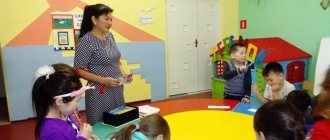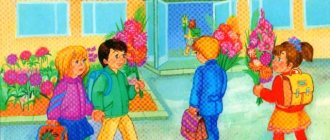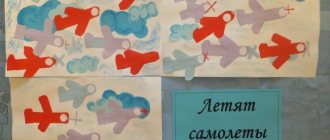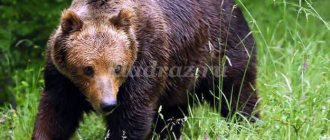Lesson on sound culture of speech “Sound I”
Topic: “Sound culture of speech, sound I”
Goal: shows interest in joint games to develop the sound culture of speech, distinguishes the sound I from other sounds; answers the teacher’s questions, knows how to listen to an adult and follow his instructions, knows how to carry out actions according to a given rule; evaluates his own activities, his capabilities.
Objectives : teach how to correctly pronounce the sound “I”, develop speech breathing, encouraging children to pronounce a vowel sound for a long time (with one exhalation). Develop skills in expressive reading of a familiar poem. Develop a sound culture of speech.
Preliminary work : looking at various pictures with the sound I in their names, reading and learning A. Barto’s poem “Horse”, didactic game “Help me find my mother”, watching the presentation “Moms and their babies” (pets and their babies).
Methods and techniques : surprise moment, situational conversation, game situation, didactic game, showing and explaining the method of action, questions to children, stimulation to action.
Equipment and materials: a toy horse, a small and large bell, turkey and hawk hats for playing, a didactic game “Help me find my mother,” pictures of a needle, iris, butterscotch, and turkey. Multimedia equipment, recording of the clatter of hooves, the sounds of a barnyard, the ringing of bells, a cartoon - presentation “Baby Pets”.
Progress of organized educational activities.
Motivational - indicative stage.
Game situation. The teacher invites the children to remember the familiar poem by A. Barto “The Horse” (reads by heart):
I love my horse
I'll comb her fur smoothly,
I'll comb my tail
And I’ll go on horseback to visit.
After reading the poem, the teacher invites the children to show with their tongue how a horse gallops (articulation warm-up). The teacher demonstrates the correct technique of “clicking” the tongue. After this, the children begin to click their tongues, the teacher helps and explains the technique of the exercise to children who have difficulties.
Surprise moment. The clatter of hooves can be heard (in the recording). A toy horse appears - a backpack.
The teacher turns to the children: - Guys, who came to us? (children's answers), that's right, a horse. But it's a little horse, a baby horse, what do they call it? That's right, his name is foal. The foal is lost and cannot call his mother horse because he has forgotten WHAT to call her. Shall we help him? (children's answers).
The desire to take part in helping the foal determines the further goal of the children’s subsequent activities.
The teacher organizes a discussion of the problem and ways to solve it, leads the children to the idea that they need to think about HOW to call the foal’s mother.
Search stage
Finding solutions, determining a work plan.
The teacher turns to the children: - Guys, which of you knows how to call your mother - a horse? Children offer their own options (ring the bell, shout, sing the foal's song).
Practical stage
The teacher leads the children to the fact that the foal calls his mother “I-i-i-i-go-go.”
- “I-i-i-i-go-go” is a horse song. Let's sing this song quietly together with the foal. (Children complete the task together and one at a time.)
— When a foal calls its mother, its song is loud and long. Like this: “I-i-i-i-go-go” (prolonged pronunciation of a vowel sound on one exhalation for 2-3 seconds).
- Let's, guys, help the foal find its mother. Let's all sing the song of the lost foal together so that mom can hear it. (Singing is repeated 2 times). The teacher explains that when pronouncing the sound “I”, the lips stretch into a smile, and the sound “Iiiiiii” is produced. When pronouncing a sound, the teacher pays attention to individual children and encourages them to pronounce the sound.
The ringing of bells is heard. (First small, then big)
- Hear, the bells are ringing, it’s the mother horse galloping after her foal. (recording of bells ringing). Our foal has a surprise for us (the teacher takes out two bells from his backpack - a large and a small one)
— The little bell sings “Liiii-liiii-liiii” in a drawn-out manner.
- How does he sing? (Children repeat).
— The big one pronounces “Deein-deein”
- How does the big bell sing? (Children speak in chorus and individually).
— The horses are running home, and we can still hear the sounds of the bells “Liiii-liiii-liiii” (children sing) “Diiiin-diiiiin” (children repeat, against the background of a recording of the ringing of bells, the foal “runs away” out the door).
The teacher addresses the children: “Guys, you did a great job helping the foal call and find its mother!” And now we will play the game “Turkeys and the Hawk”.
Physical exercise.
Turkeys walk on the grass, Walking in place
They take the turkeys with them. Walking in a squat
Turkeys scream loudly. Feet shoulder-width apart, arms back. Bend sideways and forward.
Protect turkey chicks.
A hawk appeared in the sky, hands on the belt, circling around left and right.
Spun over the family,
Ready to grab the turkey poults, arms along the body, bending to the sides, forward.
Yes, he is afraid of turkeys.
Game situation.
- Guys, we helped the foal, and let's help other animals find their mother. And before that, I want to take you on a trip to the barnyard where domestic animals live (showing a cartoon - presentation “Baby Pets”).
After watching, the teacher takes the children to the tables where the didactic game “Help Find Mom” is laid out; pictures depicting domestic animals and their cubs are laid out on two combined tables. The teacher explains to the children the rules of the game: each “child” needs to find a mother, while the “Child” must imitate the onomatopoeia of the voice of the animal shown in the picture. For example: the teacher shows a picture of a calf, asks the children a question: - Who is this (calf), who is its mother? (cow), how will the calf call its mother? (moo-oo-oo).
Game situation.
— You did an excellent job with all the tasks, and you receive a picture as a gift. Name, Masha, Ira, etc., what is drawn in your picture (the following objects are shown in the pictures: needle, iris, butterscotch, turkey), the children name and articulate the sound “I”, the teacher helps the children to identify the sound “I” with their voice in words.
Reflective-evaluative stage.
The teacher sums up the lesson, inviting the children to remember what they did today, who did they help? The children answer: we helped the foal call his mother “Eee-go-go!!!”, helped other animals find their mother, sang the song of large and small bells.
Follow-up work.
Invite children to play the game “Turkey and the Hawk” on the street, and also at home with their parents to look for the sound “I” in words.
Notes on speech development on the topic “Sound culture of speech: sound I”
- practice expressiveness of intonation when reproducing onomatopoeia;
Developmental tasks
:
- develop speech breathing,
encouraging children to pronounce a vowel sound for a long time
(with one exhalation);
— development of general motor skills of children;
- develop the muscles of the articulatory apparatus.
Educational tasks:
- cultivate independence.
- cultivate respectful attitude towards each other.
Introductory part
Target:
introduce children to the sound [I], interest them in a fun journey with a foal.
Motivation:
help the foal find its mother.
Working methods used:
- visual:
a picture of a foal with a bell around its neck, medals on strings with the image of a foal
.
- practical:
questions, conversation with children
.
Children enter the group, the teacher invites them to sit on the mat.
IN:
Hello kids, come into the group and sit on the mat.
Children sit in a semicircle in front of the teacher and the magnetic board. On a magnetic board there is a picture of a foal with a small bell on its neck.
IN:
Guys, please look at the board, who came to visit us today?
Children's answer options:
horse, little horse, little horse, etc.
IN:
Guys, what is the name of a baby horse?
Children's answer options:
small horse, foal, etc.
If the children cannot answer the teacher’s question correctly, the teacher prompts the children.
IN:
Guys, this is a foal, a baby horse. Let's all say together: “he-re-ba-nok.”
The children say the word “foal” in unison.
IN:
Milena, who came to us today?
(individual work)
In:
Lisa S., who came to us today?
(individual work)
In:
Elisha, who came to us today?
(individual work)
If children have difficulty pronouncing the word “foal,” the teacher asks the other children to help and pronounce this word in chorus again.
IN:
Guys, the foal came to us for a reason, he got lost and asks us to help him find his mother horse. Shall we help the foal?
D:
Yes, we will help.
IN:
Together with the foal we will go on a fun journey in search of his mother. And we will fly on airplanes. We start the engines.
The planes took off and landed in a clearing.
Children pretend to be airplanes and move around the group; after the teacher says, “Sit in the clearing,” the children sit in the clearing.
IN:
Guys, now you and I will turn into foals and remember how a foal screams.
The teacher gives the children medals with a picture of a foal. Children wear them around their necks.
IN:
What does the foal say?
Children's answers:
iiiiii, iiiigogo, meow-meow, woof-woof.
IN:
IIIIIIIII. Let's all sing the foal's song together.
The teacher and children sing the foal's song in chorus.





